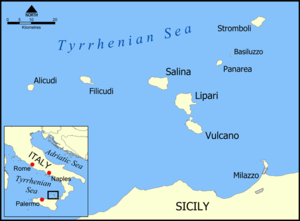Aeolian Islands
| UNESCO World Heritage Site | |
|---|---|
 | |
| Criteria | Natural: viii |
| Reference | 908 |
| Inscription | 2000 (24th Session) |

The Aeolian Islands (Italian Isole Eolie) are a volcanic archipelago in the Tyrrhenian Sea north of Sicily. They are a popular tourist destination in the summer, and attract up to 200,000 visitors annually.
The largest island is Lipari, and tourism marketing often names the entire archipelago the Lipari Islands because of the ease of pronouncing Lipari compared to Aeolian. The other islands include Vulcano, Salina, Stromboli, Filicudi, Alicudi, and Panarea. The town of Lipari has about 11,000 inhabitants. Vulcano is famous for its fango baths.
History
The Cnidian settlers under Pentathlos arrived at Lipara in 580 BC and settled on the site of the modern village known as Castello or la Cittade. They named the islands after the Greek keeper of the winds, Aeolus, whose benevolence was essential. Outside Lipara, on the road to the necropolis, a sanctuary to Demeter and Persephone has been discovered. In 394 BC the Roman embassy consisting of Lucius Valerius, Lucius Sergius, and Aulus Manlius took a golden bowl that was made as a gift to Apollo, to Delphi. The diplomats were captured by Liparian pirates, but instead of being harmed the diplomats and their offering were protected by the magistrate Timasitheus and escorted safely to Delphi, this made for peacefull relations between the two states [1]. The islands were the site of the Battle of the Lipari Islands in 260 BC between Rome and Carthage. Biblical historian Josephus mentioned a group that is probably related to the Aeolian islands: "Elisa gave name to the Eliseans, who were his subjects; they are now the Aeolians." Elisa refers to the biblical figure Elishah, grandson of Japheth, son of Javan.
In 1544, when Spain declared war on France, the French king Francois I, asked the Ottoman Sultan Suleiman for help. The latter sent a fleet headed by Khair ad Din (also known as Barbarossa) who was victorious over the Spaniards, and managed to retake Naples from them. In the course of the battle the Aeolian Islands were depopulated. Later immigrants from mainland Italy, Sicily and Spain re-established communities on the archipelago.
Inside (and next outside?) the UNESCO World Heritage Sites
The Aeolian Islands have been listed by the UNESCO as World Heritage Sites although inaccuracy, the missing closure of a pumice quarry and the oncoming building of some four harbours by the shore of the sole town of Lipari [2], that would seriously affect the natural and historical meaning of the main isle and subsequently the whole archipelag - not to talk of the social and economical impact it would carry by- seriously threaten the Islands to be outlisted as late as June 2008, according to the Italian Unesco Commission [3].
References
External links
- Template:Wikitravel
- UNESCO World Heritage Sites, Aeolian Islands
- Aeolian Islands tourism website (in Italian).
- information about Aeolian or Lipari islands
- Richard Stillwell, ed. Princeton Encyclopedia of Classical Sites, 1976: "Aeoliae Insulae (Lipari Islands), Messina, Sicily"
- Article about Aeolian Islands
- Information about the Islands Islands (in English and Italian).
- Aeolian Island facts.
- Aeolian Islands Photos.
- SiciliaOrientale.com: Aeolian Islands Photos
